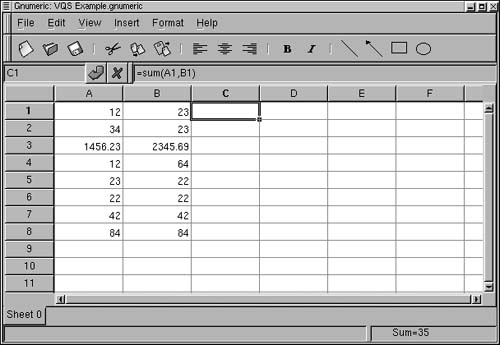Working with the Gnumeric Spreadsheet
The Gnumeric spreadsheet is a world-class spreadsheet program, and it's also a work in progress. In other words, it is very, very good right now—but not complete.
Figure 7.21. The Gnumeric spreadsheet opens with a blank worksheet ready to go.

Highlights include an extensive and powerful library of functions, an extensible architecture that accepts plug-ins, and a native XML format. An Excel import and export module is in the works.
Documentation for the Gnumeric spreadsheet is excellent.
This program is primarily the work of Miguel de Icaza. You can learn more about it at
To open the Gnumeric spreadsheet:
-
With the Gnome desktop running, select Gnumeric Spreadsheet from the Applications menu fly-out on the Gnome main menu. The Gnumeric spreadsheet will open with a new blank worksheet (Figure 7.21).
To use a function in a cell:
1. | With a worksheet open, select the cell in which you want to use a function (Figure 7.22). Figure 7.22. To use a function in a cell, select the cell and enter the function in the Input box.
|
2. | In the Input box, type an equal sign, followed by the function and its arguments. For example, to make the contents of cell C1 equal to the sum of the contents of cells A1 and B1, you would type =sum(A1,B1). |
3. | Click the Acceptance button (to the left of the Input box, with a curved arrow). The calculated total will appear in the cell. |
Autofilling
Autofill is achieved by dragging a cell using the handle box at the lower-right of the cell. The Gnumeric spreadsheet does its best to figure out what the new cells should be filled with. For instance, if the original cell was filled with a function, as in the preceding example, the new cells will be filled using the same function.
To autofill a column:
1. | Using the handle box at the lower right of the starting cell, drag down the column you want to autofill (Figure 7.23). Figure 7.23. To autofill a column, drag a cell down the column using the handle box at the cell's lower right.
|
2. | Release the mouse. The column will be filled based on the formula in the original cell (Figure 7.24). Figure 7.24. All the cells in the column are filled appropriately when you release the mouse.
|
Tip
Note that the content of the Input box for cell C8 has been automatically set to =sum(A8,B8) (Figure 7.24). This is the formula from the original cell, C1, extrapolated with the row number replaced appropriately. Other rows will have an appropriate formula: for example, the Input box for cell C5 will read =sum(A5,B5).
To get more information on Gnumeric spreadsheet functions:
1. | Choose Gnumeric Function Reference from the Gnumeric Help menu. The Gnumeric Function Reference will open in a Netscape window (Figure 7.25). Figure 7.25. The Gnumeric Function Reference provides information about the functions that are available.
|
2. | To find out more about a specific function, click the link for that function. |
Tip
The descriptions of the functions can be less than elucidating. For example, if you click the KURT function, you will learn that it is the kurtosis function, and that using it in some circumstances will cause a divide-by-zero error. There is no explanation of kurtosis. Fortunately, you can usually get information about anything using your favorite Web search engine.
(By the way, the kurtosis function is, essentially, a measure of how many outliers there are off a statistical random distribution—in other words, a measure of statistical "skewedness.")




